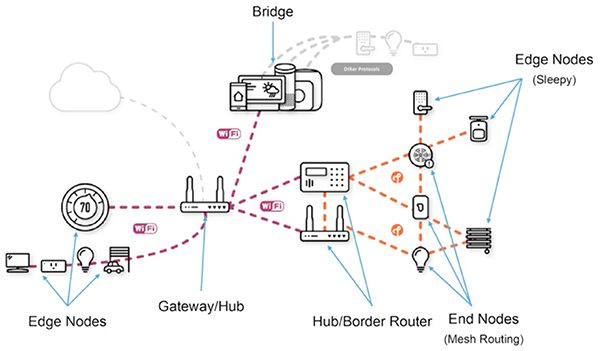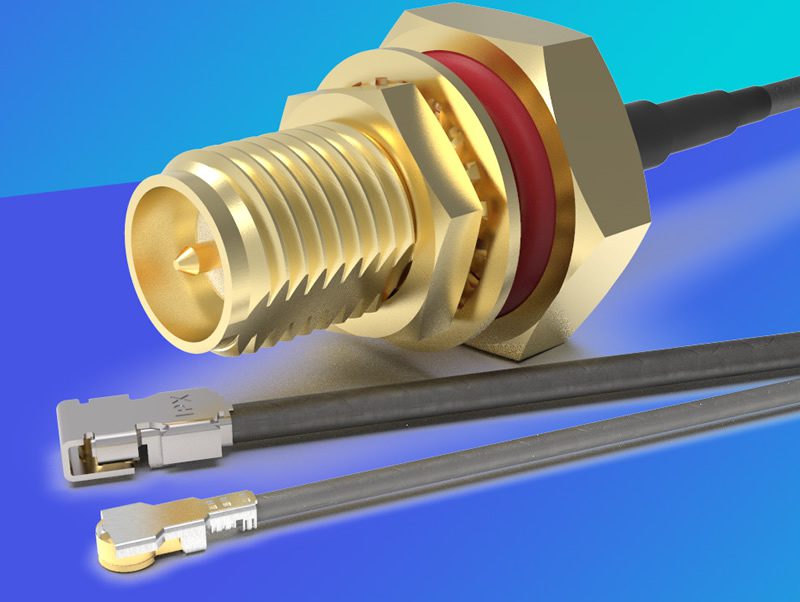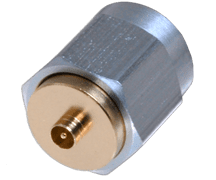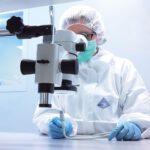Matter: A Show of Unity for Connectivity
In the history of electronics, few single initiatives have been so universally embraced as the Matter protocol. Over 200 companies have agreed on a way to seamlessly connect devices in a smart home.

One of the defining technologies of the late 20th century was the IoT (Internet of Things). Today, its network of connected nodes share data to initiate building functions such as automated environmental controls based on motion, temperature, and light sensing. The IoT also operates industrial environments and cities, where it is used to coordinate machinery, share data on resources, and manage utilities in an efficient way. It is also moving into the home, where consumers are beginning to embrace connectivity and convenience with the help of the Matter protocol.
The dream of the smart home hit a speed bump, when consumers became perplexed by the different communications protocols, cloud services, and gateways which necessitated one or more bridges to connect to other devices from an assortment of manufacturers. Going forward, Matter will simplify these connections.
The Start of Matter
In 2022, the Connectivity Standards Association (CSA) introduced the interoperability protocol Matter, building on existing wireless connectivity technologies such as Thread, Wi-Fi, Bluetooth LE, and the Ethernet wired protocol. The Matter application layer acts as a common software stack to connect compatible devices to pre-validated systems, regardless of manufacturer, function, or location of the device. It allows them to communicate locally, within the home without a cloud connection. The certification means any smart home product will be compatible with Amazon’s Alexa, Apple’s HomeKit, Google’s Nest, and Android ecosystems.
Josh Mickolio, supplier development manager for wireless and IoT at DigiKey, describes antennas as “the lifeblood of the network.” Not only is data transmitted wirelessly from a Matter device, but the antenna transmits data to add the device to the network in the first instance, as well as facilitates software updates for security or functionality.
“The interconnectivity on a Matter network is typically wireless, so an antenna is required on each device,” said Mickolio. Matter can be supported over Ethernet, but the capability has not been demonstrated in devices yet, he added.

How to use Matter to connect a smart home. (DigiKey)
The antenna type, as well as its physical size and connection, will depend on the end application. “The electrical characteristics of the antenna are straightforward, so the antenna itself just needs to support the frequency of the radio being used,” said Mickolio.
“For example, if an engineer is using a Nordic NRF54 series device, one antenna that supports 2.4 GHz can support Thread and Bluetooth connectivity.”
The antenna choice is one area where missteps can cause failures when a device is tested for certification, he noted. Choosing the right antenna and associated connector for the design can avoid costly delays.
As a wireless protocol, there are no physical connection requirements in Matter-enabled devices but IPEX, U.FL, UMC, and other small coax connectors may be used with an off-board antenna in place of a trace or chip antenna.
For consumers, Matter promises simplicity. Instead of having to work out if a Nest thermostat is Apple HomeKit-compatible, or whether an Amazon Echo device can control a third-party lock, buyers can just seek out the Matter seal of approval on devices and be assured of interoperability,” said Finn Boetius, product marketing engineer at Nordic Semiconductor.
Matter supports the Thread, Wi-fi, and Ethernet protocols for device-to-device communication and uses Bluetooth LE for commissioning and configuring devices to a network using a smartphone.
“Thread is a secure wireless mesh network developed explicitly for the smart home, tuned for reliability and low latency. It works particularly well for lower power devices such as sensors and door locks,” said Boetius. “In a typical smart home setup, lower power Matter devices would typically run across a Thread network, while devices with higher power and data bandwidth needs will use Wi-Fi.”
For manufacturers, Matter means the product development process is streamlined through a single standard, guaranteeing both compatibility and interoperability. “Matter is also IP-based, providing developers with a common and well-established foundation for communication,” said Boetius. “Matter provides interoperability between the existing smart home connectivity protocols, Wi-Fi, Thread, and Ethernet.”
Growth: A Matter of time
Initially, the Matter protocol applies to simple on/off functions, such as light switches and sensor door locks. As the standard evolves, more complex functionality and devices will be added. The industry is anticipating an increase in demand and companies are already offering development kits to support innovation. There are 1,300 certified Matter devices listed on the CAS website from manufacturers such as Samsung, LG, Landis+Gyr, OSRAM, Panasonic, Toshiba, and retail outlets such as IKEA and Home Depot.
Analyst firm ABI estimated that more than one hundred million devices supporting the specification shipped in 2022 and that more than half of the smart home devices shipping worldwide will support Matter by 2027. It also predicted that between 2022, the year of Matter’s introduction, and 2030, more than 5.5 billion Matter-compliant smart home devices will ship worldwide.
Early examples of Matter products are on the market today. They include light bulbs that dim or turn on and off at scheduled times, blinds and shades, thermostats, water leak sensors, power outlets, and wall plugs.
At CES earlier this year, Aqara introduced its Door and Window Sensor P2 with native support for Matter. As part of a home security system, it can alert homeowners if a potential intrusion threat is detected but also contribute to energy efficiency by turning off the heating thermostat if a door or window is left open in an occupied home. Yale has also introduced the Assure Lock SL with Matter, a touchscreen deadbolt for doors with entry via the touchscreen keypad. Home security systems, home appliances, motion and presence sensors, and TV and streaming video players are expected to be in the next wave of adoption as the protocol is updated.
Developing Matter
To support design and innovation, many chip companies who are also Matter signatories offer development boards to evaluate Matter-compatible chips. For example, Nordic Semiconductor offers a development kit for its nRF5340 Matter-qualified System on Chip (SoC) and one for its Matter-qualified nRF52840 Bluetooth 5.3 SoC (both available from Mouser Electronics). The nRF52840 development kit has connectors to link I/Os and interfaces together with an integrated PCB trace antenna and an RF connector for direct RF test measurements. There is also a connector for an external NFC antenna. The company also offers the nRF Connect SDK (software development kit) which includes fully integrated Matter support.

Nordic Semiconductor’s nRF52840 development kit, available from Mouser Electronics, includes a connector for an external NFC antenna.
Rob Alexander, principal product manager at Silicon Labs, said that for manufacturers, the protocol enables new innovations and differentiation by reducing complexity for connectivity. “In addition, consumers still want high quality products that have longer battery life, the best possible range and reliability, and there is plenty of opportunity for manufacturers to differentiate in that way while still using an interoperable standard like Matter,” he said.
The Matter standard provides proven technologies, including open-source software and a unified application which simplifies development, lowers development and operational costs, and reduces time to market by leveraging existing implementations, he said.
Matter protocol layer and compatible devices. (Silicon Labs)
Systems with many connected devices can pose security issues, as rogue devices may not be immediately identified and disabled. “Security is at the heart of Matter, including authentication of devices joining the network, encryption of messages all the way to the destination, use of proven and standard cryptographic algorithms, and over-the-air (OTA) updates,” said Alexander.
“In addition, its security does not rely on the security of the communication technologies it runs on top of. Security measures adopted by technologies like Wi-Fi or Thread are an added level of protection,” he explained. All Matter devices have a unique identifier and, like websites, will only work with certificates that verify the device type and brand.
The CSA’s Product Security Working Group is working on a global program to support the certification of consumer IoT products to ensure they are updated in line with standards and regulations as they emerge.
To learn more about interconnects for Matter, visit the Preferred Supplier pages for Cinch Connectivity Solutions, DigiKey, Hirose Electric, I-PEX, and Mouser Electronics.
Like this article? Check out our other articles on Smart Homes and Sensors, our Consumer Market Page, and our 2023 Article Archive.
Subscribe to our weekly e-newsletters, follow us on LinkedIn, Twitter, and Facebook, and check out our eBook archives for more applicable, expert-informed connectivity content.
- Matter: A Show of Unity for Connectivity - September 5, 2023
- Brexit Update: UK Connector Industry - March 28, 2023
- Sensors Make it Plain Sailing for a Smart Ferry - February 21, 2023








